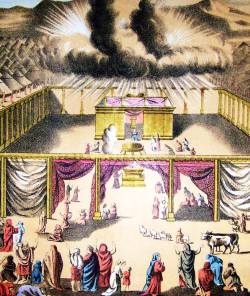This is a post on the Tabernacle in the Wilderness from an Orthodox Jewish perspective.
A Brief Overview of the Tabernacle
And they shall make me a holy [place], and I may dwell among them. (Exodus 25:8)
After giving the Torah at Sinai, G‑dasked Moses to create a home for Him, so that He could dwell among His people. This was the Mishkan.
The Mishkan (
Tabernacle) was a portable sanctuary, a spiritual center in the midst of the desert. It was the place where the People of
Israelwould bring sacrifices to atone for sins or express gratitude. It was the place where G‑d would communicate with Moses, His voice emanating from between the
cherubs atop the ark in the
Holy of Holies. It was the place where G‑d was
close to His people.
How It Began
Hundreds of years before it was built, the Mishkan was already in the works. In fact, on his way down to Egypt, Jacob planted acacia trees, instructing his sons that their descendants should take the wood with them when they leave. That way they would have the right materials on hand when the command would come to build a Tabernacle.
After Israel sinned with the Golden Calf and were forgiven, the command finally came. The Tabernacle would be a sign of the renewed closeness between G‑d and the Israelites.
G‑d specified that the work be overseen by
Bezalel of the tribe of
Judah, who was joined by Oholiab of
Dan. Bezalel was Moses’ own nephew and a
scion ofthe princely tribe, while Oholiab was of humble birth, but when it came to building a home for G‑d, all were equal. The people donated materials and set to work building, weaving, and crafting. Within a short time, the entire structure was complete.
What Was It?
The Tabernacle sat inside a large courtyard that was 100 cubits long and 50 cubits wide (a cubit is approximately 19 inches, or 50 cm). The courtyard was surrounded by a linen partition, held up by wooden poles and fastened to the ground with stakes. In the center of the courtyard stood the large copper altar, which was used for animal sacrifices. The altar was so large that there was a long ramp leading up to the top. Between the copper altar and the entrance of the sanctuary stood the laver where the priests would wash their hands and feet.
The sanctuary itself was 30 cubits long and 10 cubits wide. Its walls were made of thick, gold-plated, acacia-wood beams standing side-by-side to form three sides of a rectangle. The beams were inserted into interlocking silver sockets and were held in place by long, gold-plated, wooden poles. A hanging curtain covered the fourth side.
The roof of the sanctuary was a tapestry, woven of linen and red, blue, and purple wool. The tapestry had two separate sections, which were attached to each other by a row of hooks. The tapestry was covered by a layer of goat hair, its panels similarly attached with hooks. These two layers covered the top of the structure and hung over the wooden walls of the Mishkan. Additionally, red-dyed ram skin and tachash skin covered the roof alone.
What Was Inside?
The interior of the sanctuary was divided in two by a hanging tapestry. The anteroom, known as the Kodesh (the Holy), contained a number of items. On the southern side stood the golden menorah, whose seven branches the priests kindled every day. Near the northern wall stood a golden table, upon which the priests placed sacrificial show-bread every week. There was also a smaller golden altar upon which incense was offered twice daily.
The second, innermost room was known as the Kodesh HaKadashim, the Holy of Holies. The Holy of Holies contained the ark: a golden box that housed the Tablets (both the original, broken set and the second, complete set) and other sacred items. On the cover of the ark there were two golden cherubs facing each other with outstretched wings.
No one was permitted to enter the Holy of Holies except for the High Priest, and even he would enter only once a year as part of his Yom Kippur service.
The Mishkan was made to travel. In fact, many of its contents were outfitted with special carrying poles and protective slipcovers. There were also six special wagons that were used to transport the heavy beams, sockets and curtains.
Inauguration
For a week, Moses practiced setting up and dismantling the Mishkan. Then, on the first of Nissan, just shy of one year after the Exodus from Egypt, Moses officially inaugurated the Tabernacle. The entire tent was filled with G‑d’s Presence, evidenced by a thick cloud, which prevented everyone – even Moses – from entering.
For the next 12 days, the princes of the 12 Tribes of Israel brought inaugural sacrifices and gifts. The Tabernacle was not the exclusive domain of its stewards, the Levites (priests), but was the heritage of every Israelite.
How Long Did It Last?
The Mishkan traveled with the Israelites for 40 years in the desert. When the people entered the Land of Israel, the Mishkan came with them. For fourteen years, the Mishkan stood in Gilgal while the Israelites conquered and divided the land. Then they created a house of stone in Shiloh and spread the curtains of the Mishkan over it. The sanctuary of Shiloh stood for 369 years. At the end of that period, the sanctuary was moved to Nov, and then to Givon.
When Solomon built the Holy Temple in Jerusalem, the relics of the Tabernacle were stored deep in the earth below it. According to tradition, since the Mishkan was built with pure intent, it was never destroyed. It is ready for G‑d to once again come to rest there.








